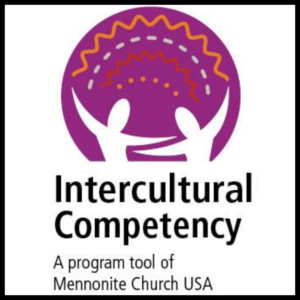With many years of intercultural experience, Rod Hollinger-Janzen assumed his intercultural competency was more than adequate, but the IDI revealed his weak points.
 Rod Hollinger-Janzen is the administrative assistant for the church vitality department of Mennonite Church USA. He is a member of Waterford Mennonite Church in Goshen, Indiana, and participates in the Poor People’s Campaign Coordinating Committee as a TriChair in Indiana.
Rod Hollinger-Janzen is the administrative assistant for the church vitality department of Mennonite Church USA. He is a member of Waterford Mennonite Church in Goshen, Indiana, and participates in the Poor People’s Campaign Coordinating Committee as a TriChair in Indiana.
________________________________________
Beginnings
I first encountered cultural differences in a significant way when I went into third grade. That year — almost six decades ago — the Canadian government began integrating First Nations students into public schools, removing them from private, church-run residential schools that had been tasked by the government to separate First Nations children from their languages and cultures. I cannot forget the day when about 10 Willow Cree children from a nearby reservation took their seats alongside the 25 white settler children in my class. As one of those settler kids, I felt uneasy. Additionally, many of the First Nations children were considerably bigger, physically, and older and, thus, developmentally in a more advanced bracket than the white kids were. The discomfort was palpable.
Relationships between these two cultures were never spoken about, and we were given no handles regarding what our respective cultures represented, or how we might best learn to live together. Thinking back on this, I realize that our teachers, too, had received little to no orientation and were at a loss. They proceeded to operate mostly in a “color-blind” manner, trying to treat all students the same way and, thus, contributing to the invisibility of the vast cultural differences between us.
In this situation, the only relevant information I possessed was what I learned in my local Mennonite church: God loves everyone, and we are called to love our neighbors. It began to trouble me that, despite this positive message, there were no First Nations people in our congregation. When I publicly asked the church leaders why this was the case, I received no answer.
I began to hesitantly engage in conversation with several of my First Nations classmates — Clarence, Joe and Karen. We at least acknowledged one another’s presence, though I had neither the awareness nor the vocabulary to engage in conversations about cultural differences. In the classroom and on the playground, the segregation was almost total. While we white boys engaged in soccer, softball or kickball, our First Nations classmates stood together under trees, in the shade, chatting or watching others engaged in play. Did I ever invite them to join the rest of us? I don’t think so.
This situation continued throughout the rest of elementary school. At best, the Cree and the white kids ignored one another. At worst, there were insults, condescension and, at times, fighting.
While I did not begin to address this racial and cultural divide as a child, it had quite a strong effect on me. A desire was planted within me, for myself and our Mennonite churches, to move toward the beautiful diversity and inclusivity of the New Testament churches. That desire has never gone away.
Moving into adulthood
It’s not surprising that, after completing my undergraduate studies, I signed up with Mennonite Central Committee, and ended up serving in Upper Volta (now Burkina Faso), West Africa. During my 2 ½ years there, I worshiped with African Christians, deepened my faith and opened my heart. I felt a call to ministry in Africa and went on to study at Anabaptist Mennonite Biblical Seminary, marry Lynda and eventually begin ministry with Mennonite Board of Missions (a predecessor agency of Mennonite Mission Network). As I prepared for ministry in Benin, I spent two years studying West African cultures, religious expressions and history. Lynda and I went to Benin equipped with significant learning and cultural insights, and we were prepared to learn more, as we entered into the lives of our neighbors and the churches with whom we had been called to work.
Intercultural work as career
Our 14 years in Benin were rich in relationships and full of relationship struggles, with disheartening times interspersed with wonderful times in ministry fruitfulness. I learned a lot about Beninese ways of thinking and doing. I also had opportunities to bump up against my own weaknesses and habitual ways of relating, some of which were positive, others more fearful, reactive and avoidant. I struggled with parts of Beninese culture that seemed to me to be unacceptable or unfathomable, so, in my eyes, less than “rational.” At other times, I found myself being much more positive about Benin’s culture than I was about my own. Beninese spirituality, through multiple experiences over many years, appeared to be richer and deeper than my own, and I could only long with all my soul for that to be my reality also.
I continued my intercultural journey through my work with Africa Inter-Mennonite Mission, where I served as the executive coordinator from 2005-2021. During this period, while based in the USA, I was able to continue a significant connection with African churches in Central, Southern and West Africa. I had the opportunity to collaborate with AIMM’s international board, which is composed of African church leaders, as well as North American and European mission leaders. Especially in the first decade after our relocation from Benin to Indiana, I experienced a struggle to “relocate” culturally, to accept and love my own culture, to understand its strengths and bear with its weaknesses. It was easier to connect with various African cultures across the continent.
The Intercultural Development Inventory
When I was asked by Mennonite Church USA to take the Intercultural Development Inventory, I had a mix of thoughts. “Oh, I know this stuff.” “Oh, what if I’m missing things that I think I’ve learned, but actually have not?” So it was with a mixture of confidence, fear and curiosity that I did the assessment.
The IDI is based on a developmental model of intercultural relationships. It identifies stages that people pass through as they wrestle with and learn in intercultural situations. These stages move toward greater complexity in both understanding cultural differences and similarities. It also assesses whether a person is able to use those understandings effectively to live, work, negotiate real differences and manage conflictual situations in intercultural settings. The stages are as follows: denial, polarization, minimization, acceptance and adaptation.
My initial results came back, and I was near the end of minimization and the beginning of acceptance. In other words, I was only a little more than halfway across the developmental spectrum.
I thought that after all those years living and interacting in cross-cultural settings, my understanding would be further along. It was humbling to see and somewhat hard to digest.
The more I’ve pondered this, the more I have been able to see that there is still room for significant growth for my intercultural relationships. A strong tendency I’ve had over the years was to cede control or minimize the problem when I came into conflict or misunderstanding with African colleagues. While such a tendency can be a strength in certain situations, in others, it led me to fail to really engage with the difference. I short-circuited the learning process, both for me and for my colleagues. I didn’t share who I really was, and thus, I didn’t provide another option to consider that could have enriched the solutions we were all seeking. In other words, when things got complex, I responded more fearfully than necessary, instead of attempting to move forward through difference and misunderstanding, thus learning to navigate in the messiness and complexity.
The IDI is a tool that has helped me to process my experiences at a deeper level. It is the best tool we have to help us take a dispassionate, measured look at where our understandings and behaviors in intercultural relationships have taken us thus far. Its usefulness is not only as a theoretical measuring stick, but there are also concrete suggestions that grow out of this inventory that help us take the next steps in our intercultural journeys.
Invitation
Many of us experience uncertainty and confusion in walking the exhilarating and inspiring journey of growth, while learning to understand and respond appropriately. I encourage you to use the IDI, if you have the desire to grow interculturally.
MC USA has a number of Qualified Administrators for the IDI. A Qualified Administrator is able to lead individuals or groups through the process of taking the IDI, processing the results, and engaging in appropriate follow-up learning. I believe that MC USA churches are seeking to grow in the capacity to relate respectfully and with love to people of all nationalities, cultures and ethnicities. After all, Revelation 7 shows that Jesus is leading the church to the place where we will all worship together! It is wise that we continue to grow our individual and collective capacities to dive deeply into intercultural spaces. I have recently become a Qualified Administrator. Feel free to reach out to me, at RodHJ@mennoniteusa.org, for more information, or to Sue Park-Hur, the MC USA director of racial/ethnic engagement, at SuePH@mennoniteusa.org.

Learn more about the Intercultural Development Inventory.
The IDI is an assessment tool that measures intercultural competence – the ability to engage effectively and appropriately with people who are different than ourselves. The IDI uses a developmental approach, evaluating individuals, groups or organizations as they work toward intercultural competence. This tool can be used to evaluate programs, develop benchmarks, create program plans and provide coaching for leaders – fostering a deeper awareness about power and privilege in any cultural context.
With Qualified Administrators across the denomination, Mennonite Church USA staff and Mennonite Education Agency are expanding access to the IDI to congregations, denominational agencies and boards, leadership teams, and other Mennonite-related organizations. Qualified Administrators are not only certified to administer the IDI but also provide feedback to individuals and organizations working to improve their intercultural competence.
The views and opinions expressed in this blog belong to the author and are not intended to represent the views of the MC USA Executive Board or staff.
Interested in submitting a blog for Menno Snapshots? Please see our blog guidelines here.

